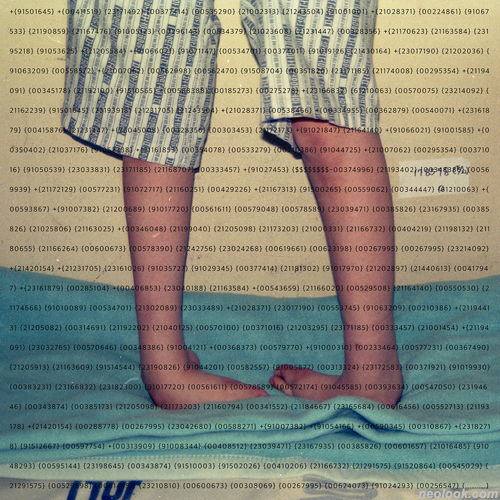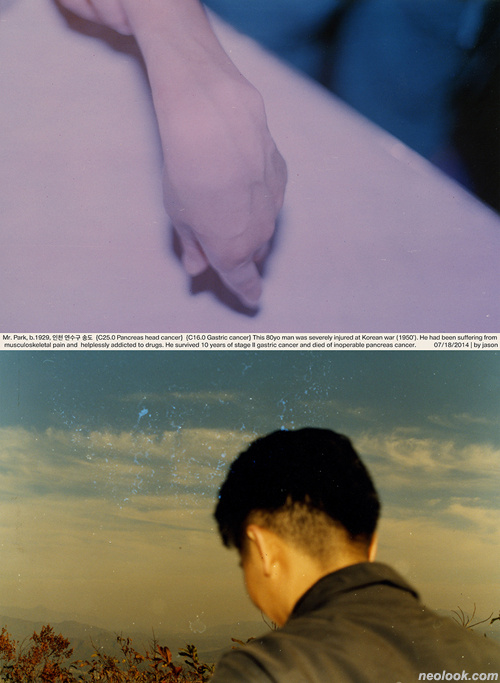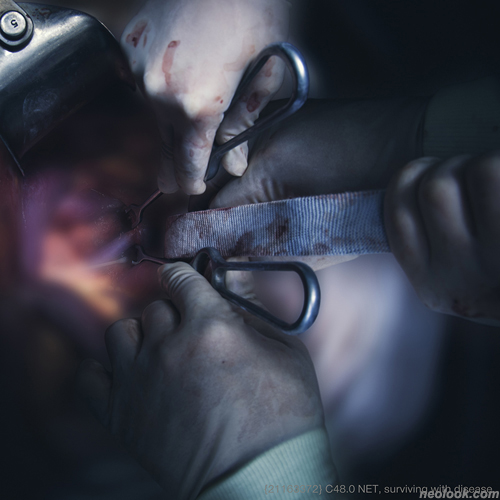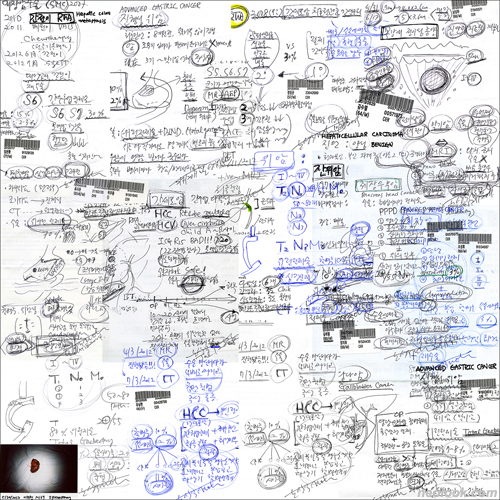- ● homepage
- ● archives
- ● restoration
- ● books
- ● big banners
- ● post board
- ■ neo's search
- ■ about us
- ■ 게재방법 안내
- 개인정보처리방침

- [email protected]
- Tel. 02_335_7922
- Fax. 02_335_7929
- 10:00am~04:30pm
- 월요일~금요일
- 3/3(월) 대체공휴일

{ blog: surgical diary }
노상익展 / Jason Sangik Noh / 魯相益 / photography 2014_1222 ▶ 2015_0122 / 일,공휴일 휴관
● 위 이미지를 클릭하면 네오룩 아카이브 Vol.20120910f | 노상익展으로 갑니다.
초대일시 / 2014_1222_월요일_06:00pm
작가와의 만남 / 2015_0109_금요일_05:00pm_세미나룸
본 전시는 서울시립미술관에서 시행중인 『Emerging Artists: 신진작가 전시지원 프로그램』의 선정작가 전시입니다.
후원 / 서울문화재단
관람시간 / 11:00am~07:00pm / 일,공휴일 휴관
사진·미술 대안공간 스페이스22SPACE22서울 강남구 강남대로 390 미진프라자 22층Tel. +82.2.3469.0822www.space22.co.kr
사진술, 의술, 죽음의 트라이앵글 ● "새로운 것의 숭배와 현대의 이념에는 일종의 저항이 들어 있는바, 새로운 것이 더 이상 존재하지 않는 것에 대한 저항이다." (아도르노,『한 줌의 도덕』) 노상익의 신작,『blog : surgical diary』는 작가의 홈페이지에 올린 수술일지를 재구성한 작업이다. 외과 의사이자 사진가인 노상익은 2008년부터『Biography of Cancer』연작을 발표해왔다. 의학논문의 주요 형식인 '도입', '재료와 방법', '결과', '결론', '토의'의 과정이 사진작업의 새로운 방법론이 되었고, 그 중 '도입'은『Presence in Trace』로 묶여 첫 번째 개인전에서 선보인다. '재료와 방법', '결과'는 2012년에『RESULTs』로 발표됐고, 세 번째 개인전인『blog : surgical diary』는 진행 중인 연작에서 파생된 작업이다. 암 수술을 집도하는 외과의사의 사진 연작은 처음부터 파격이었다. 암 병동 내부와 수술기구 및 사물에 집중한『Presence in Trace』가 '암'의 바깥을 조형적으로 보여줬다면, 환자의 개인자료와 임상차트 기록 및 검사결과 등 사진가-의사에 의해 선택된 아카이브 자료들로 구성된『RESULTs』는 보기를 중단시킬 정도로 낯설고 불편하였다. 그런데 세 번째 시리즈인『blog : surgical diary』는 낯선 상태를 계속 유지하면서 난해하기까지 하다. 익숙해질 틈을 주지 않는 노상익의 연작은 범주화가 불가능하기에 저간의 사진계로 쉽게 포섭되지 않을 듯 했으나, 첫 작업을 발표한 후부터 지금까지 사진의 미소니즘(misoneism)의 대안과 예외적인 것으로, 평론가와 주요 기획전에서 주목을 받게 된다. 다양한 시각 테크놀로지에 의해 생산되고 소비되는 소위 이미지 왕국에 살고 있는 현대인들에게 이미지는 실재를 압도할 만큼 그의 영역으로 삶의 모든 영토를 귀속시켰다. 이러한 이미지의 유혹에 맞서 싸우려는 집요하고 지독한 기록과 아카이브의 산물이 노상익의『Biography of Cancer』연작이고, 바야흐로 무서운 작가로 변신하는 모습은 세 번째 개인전인『blog : surgical diary』에서 목격할 수 있다. ● 사진가-의사의 눈과 손과 기억과 경험, 사진기록의 종합인『blog : surgical diary』는 외과의사가 특별하게 공개하는 비망록이다. 이 작업은 병원 밖의 사람들이 해독할 수 없는 기호(의학 전문 용어, 자료 사진, 바코드, 환자ID, 수술기구 등)들과 사진가-의사의 고유한 서명, 환자들의 앨범에서 가져 온 사진들로 구성된다. 일상생활의 소소한 기록이 보통의 일기라면, 노상익의 수술(외과)일기는 잘 알 수 없고, 볼 수 없었던 외과의 내밀한 기록이다. 그런데 그 기록은 발생의 원인이 아직까지 불분명하고, 그래서 재현이 불가능한 '암'이 주제이다. 누구나 알다시피, 사진은 세계를 지각하는 방식을 근본적으로 바꾸어 놓았다. 표상 불가능한 것들을 눈앞에 보이게 해주는 사진은 그 경이로운 기술로 '과학자들의 망막'이라 일컬어지기도 했다. 에밀 졸라는 '어떤 것이 사진으로 찍힌 것을 보기 전에는 그것을 정말로 보았다고 주장할 수 없다'고 말하기까지 했다. 이렇듯 사진은 육안으로 본 것뿐만 아니라 볼 수 없었던 것까지 보게 하여 새로운 학문에 대한 열망에 들뜬 19세기의 과학자들에게 실증의 도구가 된다. 육안으로 식별되지 않는 것들을 표상의 역사로 들여와 주의를 집중시키고, 현실을 인식하도록 유도한 사진은 사물의 실재를 생생하게 보유한 이미지였기에 처음 출현했을 당시부터 선망의 도구였다. 그 연속선상에서, 외과의사인 노상익은 암세포가 발생한 지점을 주위 장기와의 관계에서 어떻게 보여줄 수 있을지 고민했다. 수술 필드에서 중심이 되는 사진은 집도의가 직접 찍어야 제일 확실했던 것이다. 수술실 조명의 캘빈도를 파악하는 것은 기본이고, 카메라가 들어가야 할 때와 보여주는 방식까지 세밀하게 점검해야 했다. 결국 자기 손으로 직접 수술한 환자들에 대한 꼼꼼한 도큐먼트가『Biography of Cancer』연작의 첫 계기가 된다. 단순히 이미지를 제작하는 것이 아닌, 환자의 병을 치료하는 의사이자, 목격자, 사진가이자 기록자의 역할을 성실하게 수행한 것이다. 그의 손이 직접 닿았던 개별 환자들의 몸과 임상차트 기록 및 검사결과는 'by Jason'(노상익의 서명)에 의해 새로운 맥락으로 몽타주 된다. 이 부분은 어떠한 사진작업과도 비교 불가능한, 노상익이 선취해 낸 독보적이고 특별한 영역이다. '그때 분명히 존재했던' 것들에 외과의사의 손과 빛이 닿아 카메라에 입력된 것이기 때문이다.

- 노상익_patient's hospital IDs_C 프린트_60×60cm_2014
이번 전시에서 LED패널에 선보일 작업들은 노상익이 촬영한 사진들과 환자의 앨범에서 가져온 사진, 그리고 환자에 대한 기록들로 이뤄진다. 이는 마치 바로크 엠블럼(Emblem)을 연상시킨다. 그림(Imago)과 텍스트(Epigramm), 표제(Motto)로 이뤄진 엠블럼처럼, 노상익의 작업에서 이미지와 글자는 서로를 종속하지 않고 보충하거나 도우면서 사진기호 혹은 사진글자가 된다. 여기에서 컨텍스트를 이루는 기호들은 보편적으로 사진에 달린 설명처럼 사진의 의미를 고착시키는 것과는 다르다. 게다가 자세히 들여다보면 가독성이 있는 글자들은 오타(결함)와 여백으로 이뤄져 의미전달을 방해하기에 오히려 이미지처럼 보이기도 한다. 바로크의 엠블럼이 죽음, 시체 등 생물체의 마지막에 해당되는 모습을 통해 인생의 허무(Vanitas)를 상징적으로 제시했다면, 노상익은 파편적인 이미지들의 결합을 통해 알레고리컬한 외양을 시도하고 있다. 알레고리는 흔히 '같은 것을 다르게 말하기' 정도로 번역되곤 한다. 더 깊이 들어가면, 알레고리는 보편의 상징과는 달리 여기저기 흩어져 있는 것들이 특이하게 결합하여 완전히 새로운 이미지가 생성되기에 상징계의 위계를 벗어나 있다. 현실의 파편, 현실의 이면의 조각들이 서로 희미한 연관성을 갖더라도 한데 어울려 상호침투하는 형상들은 이성과 합리의 시선으로는 이해 불가능한 알레고리의 영역이다. 의학기술이 최첨단의 시대에 살고 있어도 '암'의 발생 원인이 아직까지 밝혀지지 않았듯이. 일반인의 눈으로는 볼 수도 없고, 해부할 수도 없는 '암'은 그동안 드라마와 영화에서 하얀 환자복과 모자를 착용한 창백한 배우들의 외양에서 다만 짐작할 수 있었을 뿐이다. 흔한 병동일지에서 벗어나, 예측 불허와 이해 불능의 영역에 놓인 '암'을 노상익이 기록과 기억과 실재와 경험으로 몽타주한 이유이다. 확정짓기 어려운, 지극히 개인적인 동시에 현대 사회에 만연한 '암'이 표상된다면, 파편화된 사건처럼 재구성될 수밖에 없었을 것이다. ● 사진가-의사인 노상익이 '지금-여기'에서 무엇을 찍고 있는가의 문제는, 그가 어떤 맥락에서 무엇을 보고 기록하는가의 문제이다. 그가 근무하는 병원은 환자의 절반이상이 국가유공자이다. 그는 한국전쟁과 베트남전쟁의 기억을 가진 환자들의 개별적인 사연에 주의를 기울일 수밖에 없었다고 한다. 환자의 입장에서, 절대적인 아우라의 자리를 점유한 의사와 진정한 소통이 이루어진다면, 그것은 이야기의 회복에서 시작된다. 환자개인과 의사개인간 관계의 구원은 서로 다른 이야기들의 어울림에 있다. 개인의 비밀스런 기억에서부터 국가의 지나온 역사를 지금-여기에서 상기시키는 것. 사진가-의사로서 노상익이 엠블럼과 알레고리로 지금-여기에서의 절망과 염려를 날것 그 자체로 작품에 호출하려 한 것은 결국 사진가-의사로서의 윤리를 묻는 일에 다름 아니었을 것이다. 고통으로 가득 찬 환자와 그것을 지켜보는 가족 사이에서 목격자로서의 사진가-의사는 환자의 죽음 이후에도 기록을 멈추지 않았고, 새로운 연관성을 획득해낸다. 환자의 수술을 집도한 외과의사의 손이 찍어 낸 환자의 흔적(trace)들은 수술실이라는 특별한 시・공간 속에서 유일무이한 개별 환자의 흔적-사진이 된다. 바로 이러한 아우라와 흔적의 공존, 특이한 감촉성으로 이뤄진 재현 불가능한 '암'적인 작품이 보는 사람들에게 큰 노력을 요구하는 까닭이다. ● 노상익의 사진이 가하는 낯섦이 충격적이라면 (그가 의학논문의 형식에 기대어 객관적으로 작업을 전개하고는 있지만) "알레고리의 목록: 예술, 사랑, 쾌락, 후회, 권태, 파괴, 지금, 시간, 죽음, 공포, 슬픔, 악, 진리, 희망, 복수, 증오, 존경, 질투, 사념" (발터 베냐민,『아케이드 프로젝트』, 조형준 옮김, 새물결, 2005, p. 786.) 이 환자와 주변(의사, 가족, 간병인, 의학 전문 잡지, 매스미디어 등)에서 끊임없이 튀어나오는 정념의 말들이고, 결코 '나'와도 무관한 것이 아니기 때문일 것이다. 작가가 '불멸하는 암의 수수께끼를 풀어내려는' 시도로 기록한『blog : surgical diary』가 '결론', '토의'의 과정에서는 어떠한 이미지에 이를지, 사진술, 의술, 죽음의 트라이앵글을 반복적으로 그리게 한다. 'by jason'의 작업들이 비타협적이고 낯설어질수록 삼각형의 의미망은 더욱 견고해질 것이다. ■ 최연하

- 노상익_Mr. Park, b.1929, C25.0_LED 패널에 와이드 컬러_100×75cm_2014
"박씨, 1929년생, 인천 연수구 송도, C25.0 췌장 두부암, C16.0 위암. 박씨는 1950년 한국전쟁 당시 심한 다발성 수상을 입었고 그에 따른 만성 통증으로 인하여 데메롤 중독이 되었다. 그는 2기 위암에 대하여 2003년 위절제술을 받았으며 항암치료 없이 10년을 생존하였으나 절제 불가능한 췌장암이 발병하여 2014년1월 사망하였다." (2014.7.18, jason)

- 노상익_Mr.Tak, b.1943, C16.0_LED 패널에 와이드 컬러_75×100cm_2014
"...POD#1 일부터 눈을 감으면 죽은 사람들이 보이고 죽은 사람들끼리 이야기하는 소리 들리다가 그 이후로는 소리는 들리지 않지만 눈만 감으면 죽은사람이 보여서 잠을 못 주무신다 합니다. 잘 때 손발을 계속 움직이면서 뭔가를 중얼거리는 양상 보이고 중얼거린 내용에 대해서는 기억을 못하십니다..." (암병동 경과기록지 중에서)

- 노상익_OR 2008 2009_LED 패널에 와이드 컬러_100×75cm_2014
"above_At August 20th 2008, 18 major operations and 14 minor procedures were done in C-rosette (6 operation rooms) / below_수술실 라운지 2009년 1월 14일" (2014.7.11, jason)

- 노상익_RETRACTORS IN SITU #1_C 프린트_100×100cm_2014
2008년 전 세계적으로 800만 명이 '암'으로 사망하였다. 이런 비극적인 세계지표 위에서 연작「BIOGRAPHY OF CANCER」이 시작되었다. 이 연작은 '암'이라는 것을 매개로 하여 만나게 되는 의사, 연구자, 환자 및 그 주변 사람들의 그칠 줄 모르는 투쟁, 환상, 희망, 절망. 죽음 과 생존에 대한 작업이며, '암'이라고 하는 불멸하는 질병의 내면으로 들어가서 성격을 이해하고 행동의 수수께끼를 풀어 내려는 시도이다. 연작은 의학논문의 형식과 같이 「도입」,「재료와 방법」,「결과」,「결론」,「토의」의 다섯부분으로 이루어 지며 이중「도입」은 2008년『Presence of Trace』라는 부제를 달고 전시되었으며 「재료와 방법」,「결과」는 2012년『RESULTs』라는 부제로 전시 되었다. 이번 작업『blog : surgical diary』은 연작의 진행 중 파생된 작업이며 실제로 본인의 홈페이지에서 진행중인 블로그를 재구성하여 제시하는 전시이다. ■ 노상익

- 노상익_{ blog: surgical diary }展_사진‧미술 대안공간 스페이스 22_2014

- 노상익_{ blog: surgical diary }展_사진‧미술 대안공간 스페이스 22_2014

- 노상익_{ blog: surgical diary }展_사진‧미술 대안공간 스페이스 22_2014

- 노상익_{ blog: surgical diary }展_사진‧미술 대안공간 스페이스 22_2014
The Triangle of Photography, Medical Practice, and Death ● "There is a sense of resistance underneath the worship of the new and the modern ideology, and the resistance is to the notion that there exists nothing new." (Adorno, Minima Moralia) ● The Jason Sangik Noh's new work, blog: surgical diary, consists of reconstructed surgical diary entries that he has posted on his homepage. He is a surgeon and photographer and has shown Biography of Cancer Series since 2008. The series is structured in the format of a medical article: 'Introduction', 'Material and Method', 'Result', 'Conclusion', and 'Discussion'. The 'Introduction', titled as Presence in Trace, was shown in his first solo exhibition. He exhibited 'Material & Method' and 'Result' under the title of RESULTs in 2012. blog: surgical diary, his third solo exhibition evolves but takes on a slightly different direction from his Biography of Cancer Series on which he has been working through his homepage. That a surgeon makes photographic series about cancer is in itself so unusual. His Presence in Trace focuses on the exterior related to cancer, showing the interior of a hospital cancer unit, operation instruments, and other objects. RESULTs, on the other hand, consists of archive materials selected by the surgeon, such as patients' private data and clinical documents and results, and is strange and disturbing enough to want to stop looking. The same strangeness resides in his third work, blog: surgical diary, and besides, it is quite puzzling to grasp. At first, categorization of Jason Sangik Noh's photography series, as it is too different to get used to it, seemed impossible for the current photographic circle to embrace it. However, ever since his first work exhibited, his work has grabbed critics' attention and been invited to major exhibitions, reviewed as exceptional and an alternative to photography's misoneism. Living in the so-called image empire in which images are produced and consumed through various visual technologies, we are well aware that images are powerful enough to overwhelm the real and to vest all territories of our lives in their domain. Resisting to such lures of images, Jason Sangik Noh has persistently relied on documenting and archiving in making Biography of Cancer Series, and by the time his third solo exhibition, blog: surgical diary is done, he has become a fierce photographer. ● blog: surgical diary, for which photographer-surgeon's eyes, hands, memories, experiences and photo-document are put together, is a memorandum, specially disclosed by the surgeon. This work consists of symbols indecipherable for ordinary people (medical jargons, data photos, bar-cords, patients' IDs, surgical instruments, etc.), photographer-surgeon's signatures, and patients' private photos. While a dairy generally means casual jottings about daily activities, the surgical diary of Jason Sangik Noh is a secretive record that we can't know at all and see commonly. The subject of the record is cancer. Its causes have not been well clarified, and thus, representing it is impossible. It is well-known that the invention of photography has revolutionized ways of seeing. The medium's capacity to show the unrepresentable was regarded so remarkable that it once was hailed as a 'retina of scientists'. Emile Zola even said, "We can't claim that we really saw a thing until seeing the photo of it." Photography that can record the invisible as well as the visible with eyes allowed the 19th century scientists to aspire for new knowledge, using it as a verification tool. Introducing the invisible with eyes to the history of representation, making them be noticeable, and allowing reality to be perceived, photography, with its capacity to produce realistic images, was regarded as a fascinating tool. Likewise, Sangik Noh, the surgeon, was seriously concerned with how to show cancer spots in relation to surrounding internal organs. Since photos are important in surgery, it is thus better if key photos are taken by a surgeon in charge. So, he has to do a basic thing like checking the Kalvin temperature of operation lighting, and consider in detail when to shoot and how to show. Eventually, his meticulous documentation of surgery led to his Biography of Cancer Series. It is not simply about making images, but about serving sincerely his patients as a surgeon-witness-documentary photographer. A new context was born as clinical records and patient checkup results were montaged by his signature, 'by Jason'. This is what makes it impossible to compare his work with other photographers', and what makes his work unique and special. That's because the record of a camera attests to a fact that beings touched by surgeon's hands and light were really there and then. ● This exhibition consists of LED panels showing photographs by Sangik Noh, those from patients' albums, and medical records, which brings Baroque emblems to mind. Like an emblem made up of an imago, epigramm, and motto, his images and texts do not overpower but complement and support each other and look like photographic signs and letters. The signs comprising a context works differently from the conventional explanatory texts that confine meanings of images. Besides, a closer look reveals the spelling errors and blanks of readable words hinder any message to be delivered, and they work like images. If in Baroque emblem the representation of the last trace of creatures like death or a corpse symbolizes life's Vanitas, Sangik Noh's fragmented images seem like an allegory. An allegory is often translated as a meaning expressed in a different way. In a deeper sense, an allegory, unlike the general symbolism, deviates from the order of symbolism, since it is made through combining seemingly different elements in an offbeat way and consequently, having a new meaning. When an image is made through combining vaguely related bits and fragmented hidden side of reality so as to mutually infiltrate, it belongs to the allegorical realm that is hard to grasp from a rational point of view. As the cause of cancer has not been discovered with the newest cutting-edge medical science, so is cancer superficially understood by ordinary people, who can't see and dissect it, only through movies and TV portraying pale looking actors with white hospital gowns and caps on. That's probably why Sangik Noh montages unpredictable and incomprehensive realm of cancer by relying solely on his own records, memories, and field experience. That's probably because in representing cancer, which is hard to clarify and very private but socially rampant, the best bet may be reconstructing fragmented cancer cases. ● What a surgeon-photographer, Sangik Noh photographs now and here (Jetstzeit) may have to do with what he documents and in what context. As he works in a hospital where more than half of patients have national merit, he has often listen attentively to their personal experiences in Korean War and Vietnam War. For a real communication with a doctor, who is in an aura-filled position from a patient's standpoint, it begins with a recovery of a story. The relational salvation between a patient and a doctor depends on rapport of two different stories. Reminding from secretive private memories to national historical past here and now (Jetstzeit), and photographer-surgeon's summoning up raw despair and worry here and now and turning them into an allegorical, emblem-like piece of work may have been eventually related to the issue of photographer-doctor's ethics. Having witnessed the agonies of patients and their families, the doctor-photographer did not stop documenting even after deaths of patients and went further to get a new relevance. Images of patients' traces made by a surgeon who performed surgery on them become unique vestiges-photographs of individual patients in such a particular time-space as the operation room. It is this aspect that coexistence of an aura and a vestige and unusual sight and touch are smeared in his unrepresentable, 'cancer-like' work that demands viewers a great deal of effort to look at his work. ● If unusualness of his work throws a shock in the face (even if his work is presented as objective medical research), that's probably because "the list of allegory: arts, love, pleasure, regret, boredom, destruction, now, time, death, horror, sorrow, evil, truth, hope, revenge, hate, respect, jealousy, and thought"(Walter Benjamin, Passagen-Werk. trans. Hyungjun Cho. Saemulgyul Publishing, 2005. p.786) must be frequent sentiments uttered by patients and others (including doctors, families, caregivers, medical journals, mass media, and so on), and those emotions are ever irrelevant to us. How his blog: surgical diary that began as a record in an attempt to solve puzzles of imperishable cancer will be unfurled in 'Conclusion' and 'Discussion', and the triangle of photography, medical practice, and death are repeatedly conjured up in my mind. The more uncompromising and unfamiliar works 'by Jason' will become, the sturdier the meaning net of the triangle will be. ■ CHOIYEONHA
In 2008, about eight million humans in the world died of cancer. With this sobering statistic, I started this work 'BIOGRAPHY OF CANCER 'at 2008. It's about encounter with cancer, dramatic treatments, euphoric success, tragic failure, deaths, and the relentless battle by doctors and patients. It is also a meditation on illness, medical ethics, and the complex, intertwining lives of concerned people. ■ Jason Sangik Noh
Vol.20141222e | 노상익展 / Jason Sangik Noh / 魯相益 / photography

